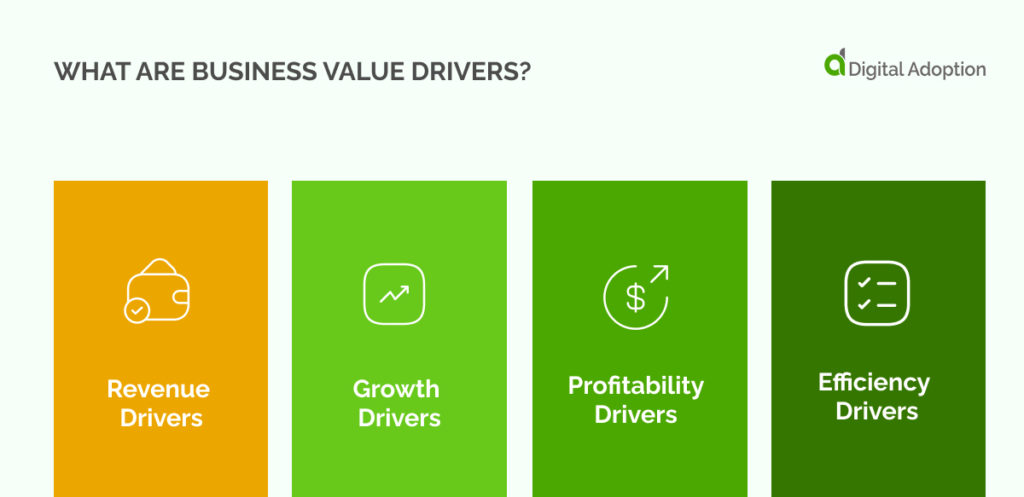Gartner predicts that through 2027, CIOs who implement these seven rules will be 75% more successful in elevating their strategic contribution to their organizations’ missions and increase approval rates for funding requests by 30% over current levels.
Value Drivers are characteristics of a business that either reduce the risk associated with owning the business or enhance the prospect that the business will grow significantly in the future. Your job as a business owner is to create value within your business before a sale by implementing key value drivers.
There are many factors to consider when driving business value. This article will focus on two of the most important ones: digital transformation and change management.
- Digital Transformation & Change Management Business Value Drivers
- What Are Business Value Drivers?
- How Does Digital Transformation Drive Business Value?
- How Does Change Management Drive Business Value?
- An Agile Approach To Driving Business Value
- Enterprise Mobility: Delivering Wins For Agile Businesses
- The Ten Most Important Business Value Drivers For Digital Success
- Making Digital Transformation A Competitive Advantage
Digital Transformation & Change Management Business Value Drivers
Digital transformation is the process of using technology to create new or improved business processes, products, and services. This can be anything from automating manual tasks to adopting new technologies like artificial intelligence and machine learning.
Change management is the process of planning, implementing, and monitoring changes to a business. This could be anything from a change in management to a change in business strategy.
Both digital transformation and change management are essential factors to consider when driving company value. By adopting new technologies and processes, you can improve efficiency and productivity, which will ultimately lead to increased financial performance.
And by effectively managing changes within your business, you can avoid disruptions and maintain a competitive advantage that helps your business cater to emerging customer needs.
What Are Business Value Drivers?

There are four main business value drivers: revenue, growth, profitability, and efficiency.
Revenue Drivers
Revenue drivers are the activities that generate revenue for a business, including selling products and services, advertising, and marketing. Revenue drivers are essential when driving business value because they directly impact the top line. Reviewing your financial statements periodically will give you a better idea of your specific revenue drivers.
Growth Drivers
A recent report by the Business Enterprise Institute found that growth drivers, including new product development and research, will be the primary drivers that help businesses to expand into new markets. Growth drivers reflect the potential for a business to grow in the future. The emergence of a connected Industry, 4.0, is one of the most critical areas of focus in the digital age and beyond.
Profitability Drivers
Profitability drivers are the activities that increase business profits. This could be anything from cost reduction to price increases. Profitability drivers are one of the most important factors to consider when driving business value because they enable a business to generate more income to reinvest in growth.
Efficiency Drivers
Efficiency drivers are the activities that improve business efficiency, including process improvement to workforce management. Efficiency drivers are essential because they enable businesses to operate more smoothly and effectively.
How Does Digital Transformation Drive Business Value?

Business executives maintain that today’s most significant barrier to digital transformation is integrating new technology with existing corporate systems. Most business systems were developed before the digital era, in some cases decades before cellphones and tablets became widespread. These systems are critical for a company’s day-to-day operations, making them difficult and time-consuming to replace.
People’s interactions with knowledge and technology in everyday life represent considerable shifts in expectations in the business world. Today, consumer mobile apps have transformed routine activities into easy, personalized, intuitive, and intelligent experiences that can be completed in a minute. Unfortunately, company technology isn’t as easy, which impacts how customers interact with companies and how employees operate inside their businesses.
The key to achieving corporate transformation goals is figuring out how to facilitate business transformation to achieve future growth. Many business processes are still manual, requiring employees to fill out paperwork, search through files, and follow up with customers or suppliers by phone or email. This takes time away from more productive activities.
Digital transformation can help business leaders achieve their goals by automating processes and workflows. Automation can reduce the time it takes to complete tasks, freeing employees to focus on higher-level work. In addition, automation can improve accuracy and consistency, providing a better experience for customers and employees alike.
Digital transformation can also help business leaders drive value by creating new customer experiences. Customer expectations have changed dramatically in recent years, thanks to the ubiquity of mobile devices and the rise of digital natives. A new-age, technology-driven customer base is on the rise, and we expect companies to provide the same level of convenience, personalization, and accessibility that they’ve come to expect from their favorite consumer apps.
How Does Change Management Drive Business Value?

Change management is a process through which organizations can transition from their current state to a desired future state. The goal of change management is to minimize the risk and disruption associated with change while maximizing the opportunity for success.
Driving business value through change management requires a clear understanding of the business’s current state, its desired future state, and the gap between the two. Once this understanding is in place, change management teams can develop a plan to close the gap and achieve the desired future state. This plan will involve identifying which changes need to be made, designing processes and procedures to support those changes, and implementing and monitoring them to ensure they are successful.
Change management is a critical process for businesses undergoing digital transformation. The complexity and scale of digital transformation can make it difficult for business leaders to manage all the moving parts effectively. Change management provides a framework for business leaders to plan, execute, and track their progress as they transition to a new digital business model.
By understanding the current state of the business, setting a clear vision for the future, streamlining financial controls, and designing and implementing a plan to get there, change management teams can help business leaders steer their organizations through digital transformation.
An Agile Approach To Driving Business Value
In our current day and age, a company that can respond quickly to customer queries usually comes out on top. If a company makes it easy for customers to complete transactions, that customer will likely stay with them. Furthermore, if a company eliminates hindrances in its operations, it will be able to attract and keep a productive workforce. You cannot have speed without simplicity.
Mobile apps, artificial intelligence (AI), and machine learning (ML) are the best way to speed up your enterprise with simplified workflows and anytime access with the ability to teach a more diversified customer base. With intelligent processing and push notifications, you can provide a custom quote faster than your competitors, have real-time inventory visibility, or decouple billing processes from paper-based work orders to enable more accurate and faster billing. The pace at which information and transactions can be made determines today’s winning companies.
Many people today use their mobile phones for shopping, banking, booking a ride, and even deciding what to make for dinner. These tasks are all quick and easy- exactly why businesses must bring this type of convenience into the enterprise. If you don’t already have mobile technologies as part of your digital transformation efforts, 64% of other organizations cite that they’re doing so. Mobile should be an essential part of business operations, if it isn’t already, something that is ingrained in the company culture.
Enterprise Mobility: Delivering Wins For Agile Businesses

Mckinsey’s Annual IT Strategy Survey revealed that technology investments are proving their worth, especially at companies making more tech-based changes and bridging more of the technology-business divide.
When executed optimally, mobility takes the data, automation, and security found in existing business applications and expands the info and transactions to peripheral areas of the company. Mobility provides a means to change outdated systems of record – ERP, eProcurement, HCM, CRM, etc. – by lengthening the reach of these systems with a much easier user experience for task completion based on role.
You can utilize mobility to connect your present business applications by leveraging the systems you have spent decades and millions of dollars developing while allowing your employees to be more efficient and effective. According to Gartner, 70% of software interaction will be mobile in the next five years. By far, the most effective and quickest way to begin any type of corporate mobility program is to concentrate on integrating corporate permissions.
Every month, your company’s most crucial employees – managers and executives – dedicate countless hours to managing corporate approvals. These include POs, invoices, time-off requests, timesheets, etc. Not only is this process excessively time-consuming, but it also lacks cohesion among the various applications. From late fees and lost revenue to delayed projects and compliance costs – these approval processes is a costly hindrance to your organization’s success.
Equity capital represents funds paid into a business by investors in exchange for common or preferred stock. This describes the core funding of a business, to which debt funding may be added. Key employees should examine financial reports detailing the company’s market share, cash flow, economic trends, and strategic vision in order to address emerging customer needs and attract prospective buyers.
You can improve business agility and provide immediate business value by simplifying the approvals process while also taking advantage of your existing business applications.
The Ten Most Important Business Value Drivers For Digital Success
Digital business transformation is a journey, not a destination. As such, it requires careful planning and execution to succeed. Here are the ten most important business value drivers that you should keep in mind as you embark on your digital transformation journey:
- Customer Centricity – Customers are more informed and empowered in the digital age than ever. They have higher expectations and are more demanding. As such, your business must be customer-centric to win its business.
- Agility – Agile businesses can adapt quickly to change and take advantage of new opportunities. They are nimble and can pivot when necessary.
- Innovation – To succeed in the digital age, businesses must be innovative. They must constantly look for new ways to improve their products and services and stay ahead of the competition.
- Efficiency – With the help of technology, businesses can now operate more efficiently than ever. Companies can save time and money by automating processes and using data analytics.
- Collaboration – In the digital age, business is no longer siloed. With the help of technology, companies can now collaborate with employees, customers, and partners worldwide.
- Flexibility – Flexible businesses can adapt their products and services to meet the changing needs of their customers. They are also able to scale up or down as needed quickly.
- Resilience – In the digital age, business disruptions are more common. Businesses need to be resilient to withstand these disruptions and continue operating.
- Security – With the increase in cyberattacks, businesses must now prioritize safety. They need to ensure that their data and systems are secure from threats.
- Privacy – In the digital age, customers are concerned about their privacy. Businesses must be transparent about collecting, using, and protecting customer data.
- Sustainability
In the digital age, businesses must be sustainable to succeed. They need to impact the environment and society while also being profitable positively.
By keeping these business value drivers in mind, you can ensure that your digital transformation journey is successful.
Making Digital Transformation A Competitive Advantage

Say goodbye to complex business processes and systems. With mobility, people can finish any task quickly, from anywhere, on any device. In other words: people are empowered, mobilized, agile, and able to self-serve.
These powerful minutes of productivity give your organization a competitive advantage. This is how innovative companies are disrupting industries and transforming themselves. They’re making digital transformation a business priority, and they’re winning.
What is your company doing to make digital transformation a priority? How are you making it a competitive advantage? Let us know in the comments below.
Still not sure how to get started with digital transformation? Check out our free eBook: A Complete Guide To Digital Transformation.













